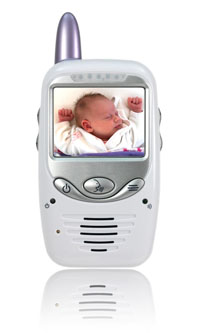 |
There is a great deal of concern among parents about the role of screen technologies in the lives of young children. Many families limit screen time in favor of creative play, time in Nature, and face-to-face interactions. The American Academy of Pediatrics and other public health organizations have stated that many young children are spending too much time with screens—and that screen time should be discouraged for infants and toddlers, and limited to one or two hours per day for older children. On the other hand, our children are growing up in a technological world and other parents argue that they must learn to use it wisely from a young age, and that research shows computers can contribute to learning. There is truth to both sides of the screen time discussion, and each family will find its own balance. However, not as much thought is given to the biological effects of computers and the other electronics in our children’s lives, which is the subject of this article. Electronic Smog It has been said that we live in an “electronic smog” – an invisible cloud of electromagnetic radiation that the World Health Organization (WHO) calls “one of the most common and fastest growing environmental influences.” The electrical wiring, computers, and any alternating current (AC) electrical appliances in our homes and commercial buildings create electromagnetic fields (EMF) – one component of the “smog” – even, in many cases, when nothing is turned on. The fields rapidly decrease with distance but appliances such as hair dryers and electric shavers, used close to the head, can give high exposures. Electric blankets and clock radios sitting beside beds produce even higher doses because people are exposed to them for many hours while sleeping. Those high tension wires that carry electricity through many neighborhoods are also culprits. Radio frequency (RF) fields – yet another component of the “smog” – are emitted by microwave ovens, TV and radio transmitters, mobile phone masts, and cell phones themselves, as well as by wireless “smart meters” that are being installed in many houses, and by those wireless baby monitors that supposedly give new parents such peace of mind. The idea of this dangerous “smog” used to be derided by many people. But many governments, researchers, and medical associations are now taking it seriously as a potential health danger. The WHO says that the smog could interfere with the tiny natural electrical currents that help to drive the human body. Researchers have begun to correlate RF exposure with diseases such as cancer, neurological disease, reproductive disorders, immune dysfunction, and electromagnetic hypersensitivity. As far back as the 1950s, it was found that relocating asthmatics to areas of low electrical fields eliminated their symptoms. But it took until 1998 for an international panel of researchers meeting in Vienna, Austria – including a professor from Queens University in Canada and a representative from the U.S. Environmental Protection Agency – to agree that the biological effects from low-intensity exposures to EMF are well-established. As with other potential health hazards, children are at greater danger than adults. One study found that a child’s growing body can absorb up to ten times the radiation an adult’s body absorbs. Wi-Fi Magda Havas, a professor at Canada’s Trent University who has studied the effects of wireless technology on human health, issued an open letter in 2009 saying she was “increasingly concerned” about Wi-Fi and cell phone use in schools. “It is irresponsible to introduce Wi-Fi microwave radiation into a school environment where young children and school employees spend hours each day,” she wrote. David Carpenter, MD, Director of the Institute for Health and the Environment, School of Public Health, University of Albany, New York, has said: “Based on the existing science, many public health experts believe it is possible we will face an epidemic of cancers in the future resulting from uncontrolled use of cell phones and increased population exposure to Wi-Fi and other wireless devices. Thus it is important that all of us, and especially children, restrict our use of cell phones, limit exposure to background levels of Wi-Fi, and that government and industry discover ways in which to allow use of wireless devices without such elevated risk of serious disease. We need to educate decision-makers that ‘business as usual’ is unacceptable. The importance of this public health issue cannot be underestimated.” The National Association for Children and Safe Technology (NACST) announced in February of 2015 that it is taking action after two recently published studies indicate there is sufficient evidence demonstrating that exposure to wireless radiation causes cancer. NACST is calling on children’s health and cancer prevention organizations to make the issue of children's health and exposure to wireless radiation in educational settings an immediate priority for 2015. Professor of Oncology Lennart Hardell, MD, PhD, and Statistician Michael Carlberg of Orebro University Hospital, Sweden found a three-fold risk with twenty-five or more years of cell and cordless phone use in a study published October 2014 in Pathophysiology. Very significant was the finding that people who first used mobile or cordless phones before the age of twenty had the highest risk. Increased wireless phone use also correlated with lower survival rates for people diagnosed with the most malignant gliomas in a second study published in the International Journal of Environmental Research and Public Health by the same researchers. In both studies, the authors state that RF-EMF should be regarded as a human carcinogen, “requiring urgent revision of current exposure guidelines.” Wireless Baby Monitors But back to those wireless baby monitors. There are many different models, with widely varying ranges, transmission settings, frequencies, and emission levels. In some cases, both the base (which is kept near the baby) and the receiver (which the parent typically carries) are capable of transmitting and receiving, so the parent can “talk back” to the infant; these units are continuously emitting radiation. Some types do not transmit signals continuously, but only when a certain sound level is reached, and some cut out the unwanted noise but not the constantly emitted radiation. Some monitor whether the parent unit is still within range of the baby unit by transmitting brief test signals every few seconds. The Swiss Federal Office of Public Health has studied wireless baby monitors. Emissions were found to decline very rapidly as the distance from the device increased, and to be consistently below their recommended limit, even at a distance of twenty centimeters (eight inches) using the most powerful device tested. Alasdair and Jean Philips of the British non-profit PowerWatch have also researched a variety of baby monitors. They note that most of the popular monitors use DECT cordless phone technology (1890 or 2400 MHz), which approaches microwave oven frequency. They have found these monitors to be “disruptive of the infant’s sleep and state of contentment” (causing restlessness, irritability, and crying). These multi-channel monitors emit sharply pulsing bursts of microwave radiation on a regular basis, which likely is the problem. Plug-in and wired units (that use your home’s electrical wiring to communicate between units) do not pulse and don’t seem to bother sleeping infants, they claim. In their research, the older type of low-band (35 to 50 MHz) analog monitors also didn’t seem to affect a sleeping baby if kept at least one meter away. PowerWatch also found that a wireless baby monitor at less than one meter away from the baby’s crib resulted in roughly the same amount of radiation experienced from a cell phone tower located one hundred and fifty meters (five hundred feet) away. So should you use a baby monitor? Trent University’s Dr. Magda Havas puts it bluntly. She says, “Exposing infants to microwave radiation, even at very low levels, is unwise. Since technology is available to provide voice-activated baby monitors…the baby monitors that emit microwave radiation continuously should be banned.” The best way to keep track of your baby is in person. But if you feel you must have a baby monitor, then use one of the old style corded models that you can probably find at a garage sale for next to nothing. (Be careful of that cord so your baby can’t get ahold of it and strangle herself, and plug the adaptor in as far as possible from the baby to minimize the EMF). Otherwise, don’t place the baby monitor in the crib, avoid using a system that transmits continuously, and set the baby unit to voice/sound activation mode.
The science is young, but there is a developing body of published research suggesting that a woman’s EMF exposure while pregnant may directly affect the health of her fetus. Findings include correlations with childhood asthma, accelerated rates of embryonic development, DNA damage, negative neurological effects, immune system disturbances, weakened bones, brain tumors, leukemia, behavioral problems such as ADHD, and even autism. There is also at least one study which found that exposure to EMF can affect miscarriage rates. Take Precautions Even though the levels of radiation emitted from, for instance, a baby monitor are relatively low, radiation exposure from wireless products is chronic and cumulative, and a child’s environment may include many devices at once. While we can’t protect our children from being exposed to radiation from cell phone towers, public wireless networks, and other people’s mobile and cordless phones, there are some things we can do in our own lives to decrease our children’s exposure to the electronic smog. So to protect your children here are some things to consider:
Learn More A Wellness Guide for The Digital Age: With Safer-tech Solutions for All Things Wired & Wireless by Dr Kerry Crofton (Global WellBeing Books, 2013) EMF Book: What You Should Know About Electromagnetic Fields, Electromagnetic Radiation & Your Health by Mark Pinsky (Grand Central Publishing, 1995) The Invisible Disease: The Dangers of Environmental Illnesses Caused by Electromagnetic Fields and Chemical Emissions by Gunni Nordstrom (O Books, 2004) Facing the Screen Dilemma: Young Children, Technology, and Early Education by Susan Linn, Joan Almon, Diane Levin (The Campaign for a Commercial-Free Childhood and the Alliance for Childhood, 2012) www.allianceforchildhood.org “Do Cell Phones and Other Gadgets Affect Our Health?” in Natural Life Magazine, January/February 2008 Wendy Priesnitz is Natural Child Magazine's founding editor; a journalist with over 40 years of experience; the author of 13 books about green living, natural parenting, and alternative education; and a contributor to many others. She is also the mother of two adult children. This article was published in 2013.
| |
![Your [Dangerously] Wired Child](https://www.life.ca/naturalchild/images/electronics.jpg)

 Fetal Exposure During Pregnancy
Fetal Exposure During Pregnancy




